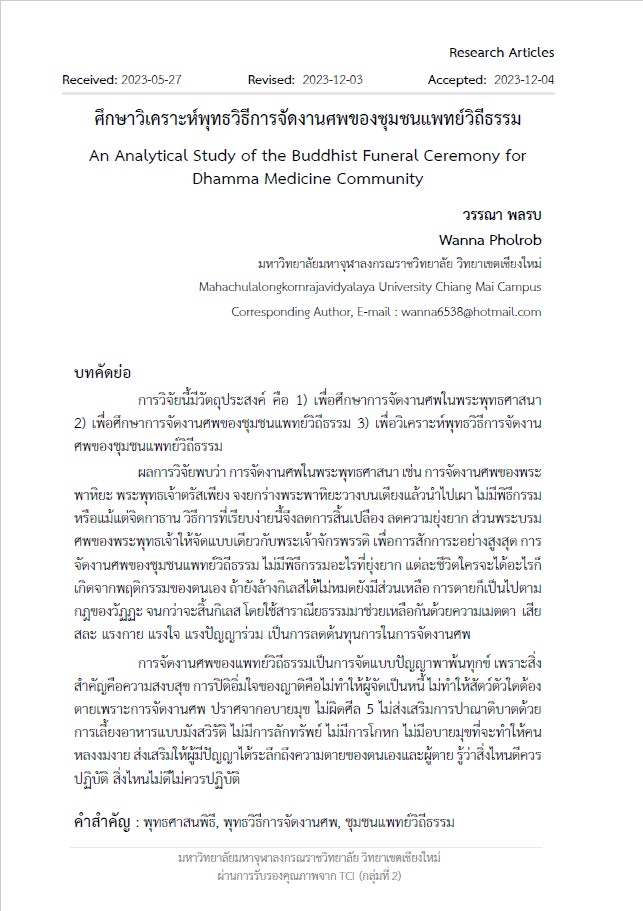AN ANALYTICAL STUDY OF THE BUDDHIST FUNERAL CEREMONY FOR DHAMMA MEDICINE COMMUNITY
Main Article Content
Abstract
The objectives of this investigation were threefold: 1) to scrutinize Buddhist funeral arrangements, 2) to explore the funeral arrangements of the Dhamma Medicine Community, and 3) to analyze the Dhamma Medicine Community's application of Buddhist funeral arrangements.
The findings indicated that Buddhist funeral arrangements, as shown by Venerable Bahiya's funeral, are distinguished by their simplicity. The Buddha just asked that Bahiya's body be placed on a bed and burned. There were no elaborate rites or crematoriums involved. This basic strategy reduces waste and emphasizes simplicity. In contrast, managing the Lord Buddha's remains required a comparable approach to that of an emperor in order to maintain the utmost level of devotion and adoration.
Within the Dhamma Medicine Community, funeral arrangements show a similar penchant for simplicity, free of complex ceremonies. Their point of view emphasizes the idea that people bear the repercussions of their choices during their lifetime. If the defilements are not completely removed, leftover components remain. Death is just viewed as a corporeal transfer, with the cycle continuing until the defilements are totally eradicated. The practice of Saraniyadhamma, or virtues for brotherly life, which encourage mutual compassion, sacrifice, physical strength, mental strength, and wisdom, helps to reduce funeral costs.
The Dhamma Medicine Community's funeral planning policy represents the use of knowledge to alleviate suffering. The achievement of peace is the basic tenet. It promotes relatives' comfort without putting financial strain on the organizers. The funeral preparations forbid animal sacrifices, abstain from any infractions of the Five Precepts, and do not support lavish feasts, instead choosing vegetarian meals. Dishonesty, thieving, and deceitful vices are prohibited by the protocols. They create a knowledge of virtuous deeds to seek and unvirtuous actions to avoid by encouraging conscious contemplation of mortality, both one's own and those of the departed.
Keywords : Buddhist Ceremony, Buddhist Funeral Ceremony, Dhamma Medicine Community.
Article Details
References
มหาจุุฬาลงกรณราชวิทยาลัย. (2539). พระไตรปิฎกภาษาไทย ฉบัับมหาจุุฬาลงกรณราชวิทยาลัย. กรุุงเทพมหานคร: โรงพิมพ์มหาจุุฬาลงกรณราชวิทยาลัย.
พระครูศรีรัตนากร. (2562). วัตถุุประสงค์ที่ แท้้จริงของการจัดงานศพที่ปรากฎในพระพุุทธศาสนา. สังคมศาสตร์วิชาการ. 12 (1), 53.
สุุนทร สุุทรัพย์ทวีผล. (2562). การศึกษาการจััดงานศพที่่ปรากฏในคัมภีร์พระพุุทธศาสนา. บัณฑิตศึกษาปริทรรศน์. 7 (2), 294-295.
เสฐียรโกเศศ. (2531). ศาสนาเปรียบเทียบ. พิมพ์ครั้งที่่2. กรุุงเทพมหานคร: ราชบัณฑิตยสถาน.
อารดา ฉิมมากููร. (2550). ธุุรกิจรับจัดจัดงานศพออนไลน์. วิทยานิพนธ์วิทยาศาสตร์มหาบัณฑิต มหาวิทยาลัยวลัยลักษณ์.


